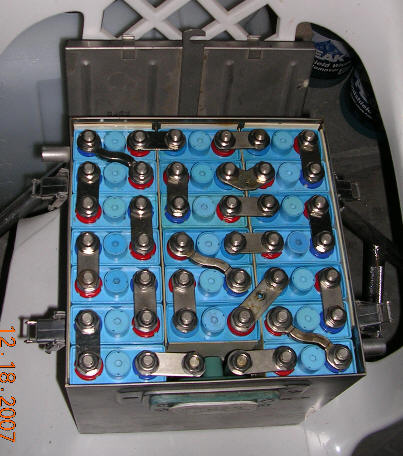Disclaimer: I've never done this on a hybrid battery, or any battery for that matter. In fact I didn't even stay in a Holliday Inn Express last night, but we have a machine that load tests our aircraft batteries and I think I can break down it's automated procedures into something we can do in our garage:
So it looks like at the lowest level your cells look something like this:

Where as our aircraft batteries look like this:

Physically it looks different, but if you look at the top picture it looks like 1+ and 1- are right next to each other just like in our aircraft battery cells and the rest follow suit. I bet there's a drawing on google that will tell us which is which.
So when we do our scheduled checks we first hook up a machine to the + and - of every cell to read the voltage. We have 20 cells that total 28vdc, so that's 1.4v per cell. Our job guide says that any difference of .1v needs to be "looked at". Since you don't have access to the same machine I might suggest finding the best multimeter you can and doing the same check one cell at a time (maybe write down your results for comparison at the end?)
If this goes well and all your cells read exactly the same minus one or two that read significantly less then I would say "that's that" and replace the bad cells. If your readings are all over the place then something's different (either the info doesn't relate, or your meter sucks, or there's something I'm missing).
But that's not a "load test". That's just a "voltage check" at the cell level. For a "load test" we need a "load" (really just a low resistor). Something like this:

If we use 12v car battery load testers as an example (they are usually rated at 500amps for a 12v battery) then we're looking at a load resistance of .024 for a 12v source.
I think we can safely assume the load tester would be rated ABOVE the max discharge rate of a car battery then at a 70% duty cycle we're looking at 350 amps, 12v (still), and a resistance of .34 ohms. We can keep using ohm's law to find out what resistance we'd need for your cells, but honestly it sounds like we just need a wire that will handle the current.
Expected current = voltage of cell / resistance of wire
I would suggest rigging up a clip system that allowed you to connect your "load wire" and your multimeter to the battery at the same time. The multimeter should already be on and set for DC voltage. Maybe a push-button switch could be used on the wire to control when the battery was put on a load?
The procedure would be to connect the load and meter to each cell's +/- for about 5 seconds. Write down the voltage, repeat, compare, and look for any deviation from the "norm". Replace the suspected cells as necessary. Of course this is again assuming you get a consistent reading from all but a few cells.
You might want someone with a stopwatch to keep your times consistent as you're looking for deviations in voltage from cell to cell. Any deviation in time (longer or shorter) could give you false readings. Our machine just says "test complete" and lets us know which (if any) need to be replaced.
There's also a capacity check that'd tell ya more, but we let that run overnight and it involves completely discharging the batteries (8+ hours?)... Not sure if we want to do that with yours.
Couple things to note:
-
armchair amateur here. I've never done this manually, and I've definitely never done this to a hybrid (and I are teh scared).
-
our battery cells are NOT the same. We use lead acid, you're probably nicad, or lithium ion, or unobtanium exotic, or something else that we're not. The tests may or may not translate and may or may not have catastrophic effects on your cells.
For the "balance check" we generally have a "balance charge" option on our machine. Before we go replacing battery cells we have the option of charging at a higher than normal voltage level for longer than normal to bring up the low cells. We then do another voltage check and load check to make sure they were just "out of balance" and not "weak". I'd be a bit nervous to do the same thing on your batteries without some sort of written guide.
Good luck!






































